Environmental Initiatives
- Policies and
Management Structure - Climate Change
Initiatives - Environmental
Initiatives - Social
Initiatives - Governance
Initiatives - External assessment
- Sustainability Report
(Issued July 2023)
MTAM is working to reduce the environmental impact of the portfolio of all the properties held by MTR (excluding land with leasehold interest) in accordance with “Promoting energy saving and GHGs emission reduction” and “Contributing to recycle-oriented society,” which form part of its sustainability policy.
Environmental Management System (EMS)
MTR’s asset management company has built an environmental management system to promote energy saving, reduction of greenhouse gas (GHG) emissions, and effective use of resources.
MTR sets targets for CO2 emissions, energy consumption, and water consumption, observes the results, carries out plan-and-result management, and takes measures to contribute to the creation of a sustainable recycling society through the reduction of the environmental burden.
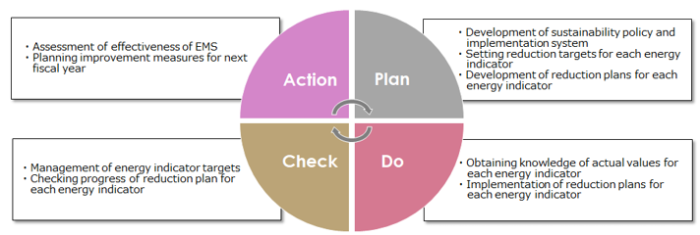
*The confirmation of a third party (Yasui Architects & Engineers, Inc.) has been obtained regarding total CO2 emissions, energy consumption and water consumption across the portfolio (excluding land with leasehold interest).
Examples of Environment Initiatives
Introduction of LED Lighting
MTR introduced LED lighting and lighting equipment with human sensors successively in rooms for rent and common areas of the properties held. Energy saving activities for reducing the environmental burden are promoted.
(Examples of introduction)
Tokyo Shiodome Building, ON Building, Kioicho Building、Kamiyacho Trust Tower,
Sendai MT Building, Osaki MT Building, Midosuji MTR Building, Hiroo MTR Building, Tenjin Prime、
Shin-Yokohama TECH Building, SHIBUYA FLAG, Ito-Yokado Shonandai,
Hashimoto MTR Building, Hotel Okura Kobe, Park Lane Plaza,
Shangri-La Tokyo, Hilton Odawara Resort & Spa, Courtyard by Marriott Tokyo Station,
Courtyard by Marriott Shin-Osaka Station, Hotel Sunroute Plaza Shinjuku
-
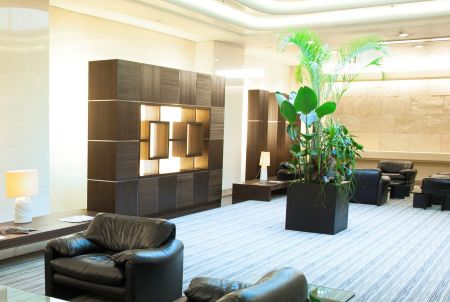
Kioicho Building
-
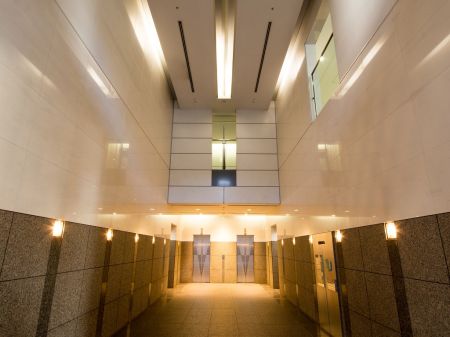
Hiroo MTR Building
Introduction of Highly Efficient Heating Systems / Renewal of air-conditioning systems
MTR is working on increasing comfort and reducing CO2 through the introduction of highly efficient heating systems whose energy efficiency is excellent and renewal with highly efficient air-conditioning systems whose energy saving performance is high upon the replacement of air-conditioning systems.
(Examples of introduction)
Tokyo Shiodome Building, ON Building, Kioicho Building, Kamiyacho Trust Tower,
Osaki MT Building, Midosuji MTR Building, Hiroo MTR Building, Tenjin Prime,
Shin-Yokohama TECH Building, SHIBUYA FLAG, Ito-Yokado Shonandai,
Hashimoto MTR Building, Hotel Okura Kobe, Park Lane Plaza
Shangri-La Tokyo, Courtyard by Marriott Shin-Osaka Station, Courtyard by Marriott Tokyo Station,
-
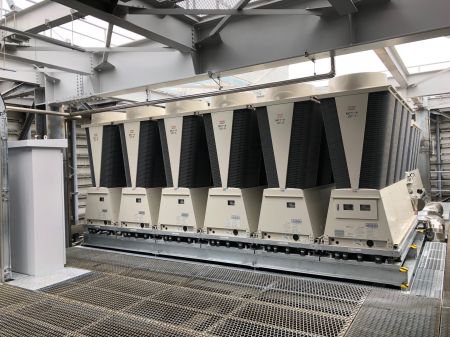
Shin-Yokohama TECH Building
-
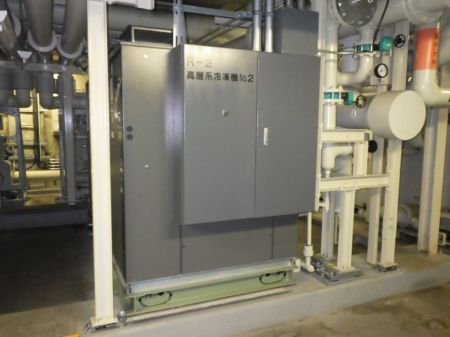
Hotel Okura Kobe
Promotion of zero CO2 emissions from electricity usage
MTR is promoting the use of CO2-emission free power through the use of non-fossil certificates, etc.
(Examples of introduction)
SHIBUYA FLAG (RE100 initiatives)
Courtyard by Marriott Tokyo Station (RE100 initiatives)
Introduction of Building Energy Management Systems (BEMS)
MTR is working to introduce building energy management systems (BEMS) in the properties it owns to measure the energy efficiency of entire buildings, thereby achieving energy saving and creating optimal indoor environments.
(Examples of introduction)
Kamiyacho Trust Tower
Courtyard by Marriott Tokyo Station
Introduction of smart meters
MTR is focusing on the efficient use of energy by utilizing smart meters to understand details such as the amount of power that is consumed and the time it is consumed.
(Examples of introduction)
・Kamiyacho Trust Tower・Osaki MT Building
Water-saving through reduction of water consumption and toilet equipment renewal
MTR is working to conserve water in the common areas of the properties it owns by installing automatic sink faucets and replacing hygiene equipment with products with high water-saving performance.
(Examples of introduction)
Tokyo Shiodome Building, ON Building, Kioicho Building, Kamiyacho Trust Tower,
Osaki MT Building, Midosuji MTR Building, Hiroo MTR Building, Tenjin Prime,
Shin-Yokohama TECH Building, Ito-Yokado Shonandai, Hotel Okura Kobe,
Shangri-La Tokyo, Hilton Odawara Resort & Spa, Courtyard by Marriott Tokyo Station,
Hotel Sunroute Plaza Shinjuku
Properly Dealing with Environmental Issues such as Contamination (Brownfield Redevelopment)
When acquiring real estate, assessing beforehand whether there are harmful substances such as PCBs or asbestos, soil contamination or other environmental issues is an integral part of the process.
We deal with any issues with real estate held such as the presence of harmful substances through appropriate measures, management or treatment in accordance with laws and regulations.
Example: Frespo Inage (Land with leasehold interest)
Although soil contamination was confirmed in the property prior to MTR’s purchase of the land, the former owner implemented land remediation work, and MTR acquired the property after confirming that such work was properly conducted in accordance with laws and regulations.
Collaboration with Tenants and Suppliers
Introduction of green lease
MTR and tenants have concluded an agreement of understanding for a green lease, aiming to reduce the environmental burden.
Information sharing about electricity, gas and water consumption and discussions on the improvement of environmental performance will be conducted.
In addition, MTR has introduced an initiative where MTR will carry out energy-saving installation work in the units of some tenants at Osaki MT Building at MTR's own expense and a portion of the installation costs will be returned as green lease payments from the tenants.
Reduction of waste
When carrying out construction work, MTR is continuously working to reduce waste in collaboration with contractors.
Hotel operators are striving to reduce waste and be environmentally conscious by using paper straws, discontinuing the use of individually packaged shampoo and reducing food loss at the hotels we manage.
Supply chain management
When selecting a property management company, MTR assessed the candidates’ activities related to sustainability in addition to their facility operation and management, lease operation and management, and leasing operations.
ESG Awareness-Raising in Backyards
The hotel operator of Courtyard by Marriott Tokyo Station educates hotel employees on energy conservation and other ESG issues, for example displaying posters in the backyard.
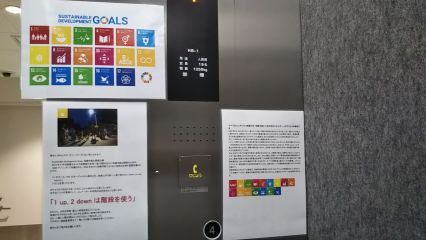
Environmental Considerations for Redevelopment
Protection of Biodiversity
ON Building and Osaki MT Building, which are owned by MTR, have formed Osaki Business Garden, a large-scale redevelopment project. The site has an open space full of greenery, worthy of the name "Garden", and contributes to symbiosis and coexistence with nature and the protection of biodiversity.
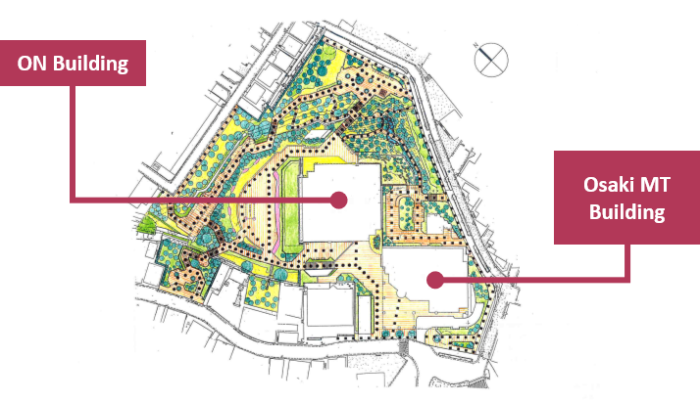
The Kamiyacho Trust Tower provides a comfortable green space and a waterfront terrace for waterscape relaxation, among other facilities. We conserved a large camphor tree, which is more than 100 years old, by transplanting it within the premises with the traditional tatebiki (tree sliding) method, creating a biodiversity-conscious biotope in the 5,000-square-meter green space that offers the area's original landscape.
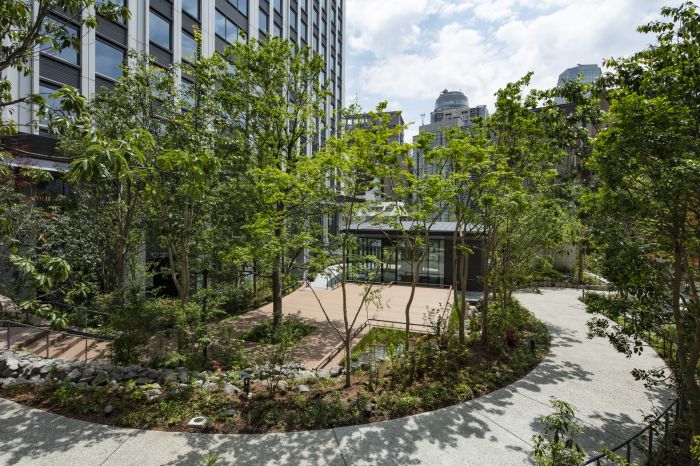
Initiatives to vitalize communities and improve the quality of the urban environment
Our sponsor MORI TRUST CO., LTD. has formulated the Kamiyacho God Valley Vision as its vision for new urban development in the Kamiyacho area of Toranomon in Minato Ward, which is being development as a new international hub of Tokyo and work to vitalize the communities. Specifically, global and advanced companies and organizations with ties to Kamiyacho and the local town council come together to regularly hold "TOKYO God Valley WEEK" and "Food Festival" which offer content for people from all walks of life, including world sports, entertainment, technology, area history and culture, wellness, food, and more.
For further details on the Kamiyacho God Valley Vision (Japanese only)
Environmental Performance Data
Environmental Performance Targets
In FY2021, MTAM has set reduction targets for total CO2 emissions, energy consumption and water consumption across the portfolio for FY2021 to FY2025, as shown below. We have set its targets for CO2 emissions reduction, bearing in mind the Japanese government target of reducing CO2 emissions in fiscal 2030 by 46% from their level in fiscal 2013.
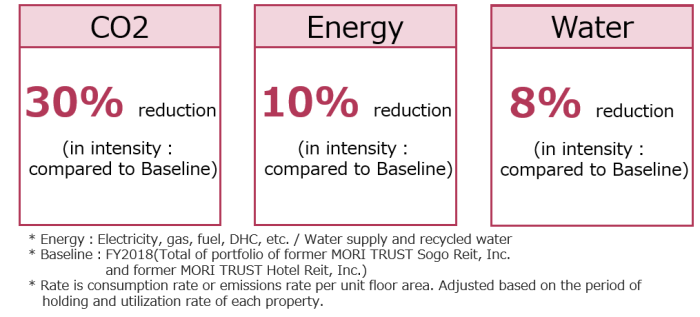
All reduction targets set for FY2016 to FY2020 have been achieved, as shown below.

Environmental Performance Data
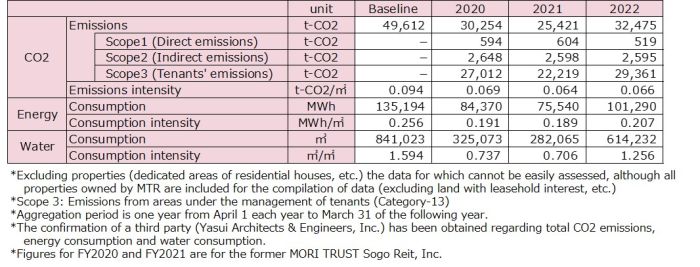
Management of waste
We are working on the continuous reduction of waste by properly managing waste in our portfolio.

Green Finance
The Asset Management Company (“MTAM”) which manages the investment corporation (“MTR”) is committed to “Promoting GHGs emissions reduction and energy saving”, “Contributing to recycle-oriented society”, “Responding to climate change and improving resilience”, “Disclosing ESG information” as stipulated in sustainability policy. MTAM has formulated a green finance framework with the aim of further promoting ESG investment and strengthening funding base of MTR by expanding the number of investors and lenders interested in ESG investment and financing.
Green Finance Framework
(Use of Funds Procured)
Funds procured of the green finance will be used for the acquisition of assets that meet the following eligibility criteria (“the Eligible Green Projects”) for the repayment and redemption of loans or investment corporation bonds that were required for acquisition of assets that meet the Eligible Green Projects or for repair work that meets the Eligible Green Projects, etc.
(Eligibility Criteria)
(1) Green Buildings
Any assets with the following valid certifications that have already been obtained or updated or are planned to be obtained or updated in the future.
① Three, Four or Five stars by DBJ Green Building Certification
② B+, A or S Rank by Certification for CASBEE for Real Estate
③ Three, Four or Five stars by BELS Certification
④ Silver, Gold or Platinum by LEED Certification
⑤ Stage 2 or higher in both heat insulation capacity of the building and energy-saving capability of the
equipment systems of Tokyo Metropolitan Government’s Environment Performance Certificate Program.
(Included in AA or higher in both heat insulation capacity of the building and energy-saving capability of
the equipment systems of Tokyo Metropolitan Government’s Energy Performance Certificate Program (2017 standards))
⑥ Properties that qualify as ZEB (Net Zero Energy Buildings)
(Properties that fall under any of definitions of ZEB, Nearly ZEB, ZEB Ready, or ZEB Oriented)
(2) Renovations on owned assets that meets any of the following criteria:
① More than 30% reduction in CO2 emissions or energy consumption
② More than 30% reduction in water consumption
③ Equipment renovations aimed at making environmentally beneficial improvements.
(In principle, the renovation that is expected to reduce usage by 30% or more compared to conventional products)
④ More than one level of star/rank improvement in the green building certifications listed in Eligibility Criteria [1]
⑤ Installation, introduction, and acquisition of renewable energy-related equipment on the premises of owned assets
(Process for Project Selection)
The selection process for property acquisition, renovation, equipment installation, etc. that meets the eligibility criteria is as follows.
Projects for which the procured funds will be used (property acquisition, renovation, equipment installation, etc. that meet the eligibility criteria) will be examined for compliance with the eligibility criteria by the Strategic Management Department of MTAM. When procuring funds through green finance, the process goes through the following process in the same way as regular finance (execution of borrowings, issuance of investment corporation bonds).
<In the case of green loan>
It will be approved by managing director in charge of the Strategic Management Department of MTAM and will be approved and executed by president and representative director.
<In the case of green bonds>
It will be approved and executed by the Board of Directors of MTR (if a comprehensive resolution regarding the issuance of investment corporation bonds was passed by the Board of Directors of MTR, it will be executed after the approval of the executive director of MTR).
Furthermore, after-the-fact reports will be made at the Meeting for Promotion of Sustainability of MTAM, which is held four times a year, regarding the procurement of funds through green finance for targeted projects.
(Allocation Plan)
After funds procured of the green finance are deposited into MTR’s account, it will be allocated to acquire the assets that meet the following eligibility criteria (Eligible Green Projects), to refinance existing loans or to redeem investment corporation bonds (including green bonds) already issued.
Reporting
(Allocation Reporting)
The allocation plan and the following items will be disclosed once a year on the MTR’s website until the green finance proceeds are fully allocated.
・ The balance of green finance procurement
・ The limit of green eligible debt
・ The status of green finance allocation
・ If there are unallocated funds, the unallocated amount and expected allocation date.

(Impact Reporting)
The following items will be disclosed on MTR’s website once a year to the extent practicable.

<Types of certification of acquired assets and evaluation status of them>
Please see “External assessment” for information on the acquisition status of green building certifications, energy efficiency ratings, etc.
Furthermore, please see “Environmental Performance Data” for information on CO2 emissions, energy consumption, and water consumption for the entire portfolio.
“Environmental Performance Data”
Evaluation by External Organization in green finance framework
MTR has received the highest overall rating of “Green 1” from Japan Credit Agency, Ltd. (JCR), which is a green finance rating agency, regarding the eligibility of the green finance framework.